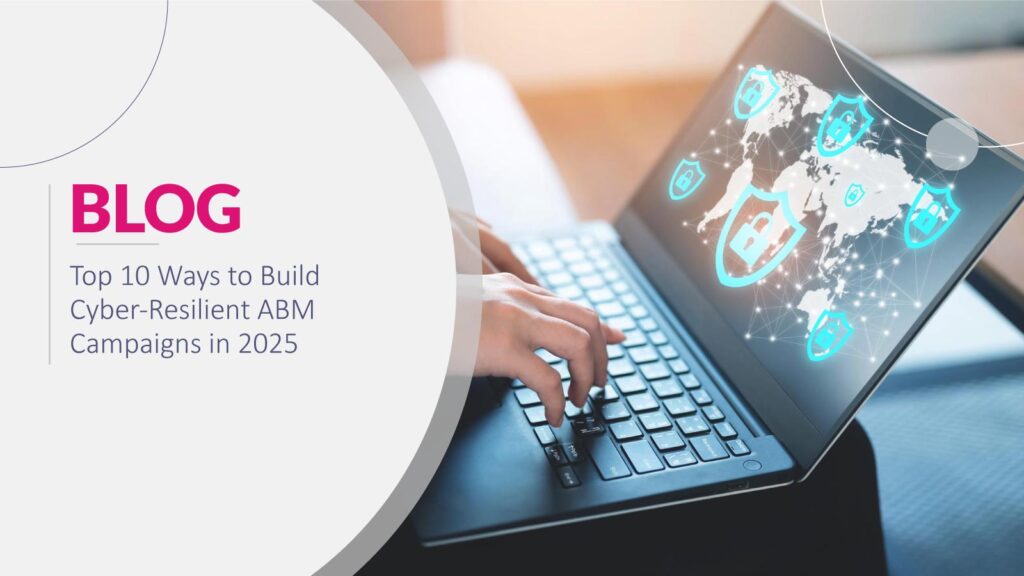In 2025, a successful ABM campaign isn’t just about getting to the right accounts; it’s about creating your cyber-resilient strategy. With evolving cyber threats, ABM campaigns are now more susceptible to cyber attacks. A cyber-resilient ABM is not simply about data security; it’s about crafting campaigns that are able to endure breaches, adapt to new threats, and keep driving business growth.
Certainly, ten key tactics for creating cyber-resilient ABM campaigns in 2025 are covered in this article. Whether it’s streamlining existing methods or creating fresh ones, these techniques will get your ABM campaigns prepared for whatever the virtual world has planned.
1. Learn the Threat Landscape Before You Strike
A cyber-resilient ABM campaign starts by understanding the threat environment. Cybercriminals are constantly seeking vulnerabilities, and also your ABM data may be an easy mark. Whether phishing or data interception attempts, understanding your vulnerabilities is essential.
Before initiating any campaign, evaluate your security vulnerabilities, especially in lead generation. Make sure your tools, platforms, and also data capture systems are current with the most recent security standards. Knowing possible threats, you actively shield your campaign and data from the beginning.
2. Lock Down the Data That Drives Your Personalization Cyber-Resilient ABM
Personalization is key to ABM, but the information fueling these campaigns is a prime target for cybercrime. To make your ABM campaigns cyber-resilient, it’s critical to protect this information.
Encrypt data in transit and at rest, and limit access to authorized parties. Continuously audit the systems holding sensitive information and have tight access controls. By safeguarding your data, you not only protect your business but also build trust with your prospects, assuring the long-term sustainability of your ABM strategy.
3. Don’t Trust the Stack but Audit It Constantly
The platforms and tools that fuel your ABM campaigns are both a strength and a potential weak point. With automation, AI, and data analytics at the center of contemporary campaigns, it’s crucial to audit your technology stack regularly.
Make sure that all of your products, including marketing automation systems and CRMs, have the most recent security fixes installed. Regularly scan third-party integrations for potential security weaknesses. Regular auditing strengthens your ABM campaigns so that they are resilient to evolving cyber threats.
4. Embed Layer Security into Intent Data and Signals
Intent data is a powerful tool in ABM, but it’s also an excellent target for cybercriminals. To make your ABM campaigns strong, place robust security layers around intent data.
Protect the collection and handling of intent signals by using encrypted databases and safe APIs.Restrict who sees sensitive data with access controls, and have anomaly detection systems to catch suspicious behavior in advance. Protecting intent data keeps your campaign agile and secure from would-be attacks.
5. Assemble Your Cyber-Resilient ABM Group Like a Cybersecurity Group
Your ABM team can’t be cybersecurity experts, but must be aware of cybersecurity issues. Creating an ABM cybersecurity-resilient strategy is collaborative, and everybody should have strong basic cybersecurity concepts.
Offer training on issues such as recognizing phishing attacks, good communication practices, and data protection. If all members of your team are singing from the same hymn sheet, minor security concerns can be dealt with immediately before they become major headaches. Security-first culture will make sure your ABM approach is robust.
6. Segment Your Campaigns Like a Zero Trust Model
The Zero Trust paradigm, never trust, always verify, and works ideally for ABM. Securing every touchpoint as a possible entry point for attacks reduces risk and improves security.
Segment your campaigns by different levels of accounts or industries, where every segment would be examined by the same security level. Segmentation reduces the impact of the breach since the whole campaign can’t be attacked with a segment attack. Implementing a Zero Trust approach enforces more secure, cyber-resilient ABM initiatives.
7. Integrate Real-Time Threat Monitoring for Campaign Assets
Cyber-resilient ABM campaigns involve monitoring campaign assets around the clock for suspicious activity. Whether it’s an email campaign or a landing page, every digital touchpoint needs to be actively monitored for possible vulnerabilities.
Invest in technologies such as intrusion detection systems, automated vulnerability scanning, and live alerting technologies. These technologies allow your team to identify potential threats early, so they can move swiftly and contain any damage. Real-time monitoring puts your team ahead of the threat in protecting your ABM campaigns.
8. Plan Cyber-Resilient ABM Workflows Keeping Incident Response in Mind
While prevention is key, preparation for a breach is equally vital. A cyber-resilient ABM strategy needs to include incident response techniques within each workflow.
Develop a defined process for managing security breaches, such as an assigned response team, established roles, and communications plan for the purpose of alerting stakeholders and affected customers. A prepared response plan will see your team recovering quickly and doing as little harm as possible so that the campaign can proceed as little as possible.
9. Incorporate Cybersecurity in ABM KPIs for Cyber-Resilient ABM
In a cyber-resilient ABM campaign, cybersecurity metrics need to be included in your key performance indicators (KPIs). Although traditional KPIs such as conversion rates and engagement are crucial, security-related metrics need to be tracked closely as well.
Monitor incidents such as data breach attempts, response times, and security compliance. Adding these KPIs focused on cybersecurity, you guarantee security is given attention along with campaign performance. It also reminds stakeholders that the protection of the integrity of the campaign is as essential as gaining outcomes.
10. Work with IT and Security Early and Often
Building cyber-resilient ABM demands close interdepartmental collaboration among security, IT, and marketing teams. Getting IT and cybersecurity experts onboard from the outset guarantees that threats and weaknesses are identified at an early stage in the planning process.
Periodic interdepartmental collaboration guarantees your ABM approach aligns with overarching organizational cybersecurity initiatives. Having a unified security approach fortifies your campaign and boosts overall resilience, enabling your marketing activities to remain secure from new threats.
Continuous Improvement: Shaping Your Cyber-Resilient ABM Strategy
Creating a cyber-resilient ABM campaign is an ongoing process. As threats in the cyber world change, so must your plans. Resilience is not a one-time endeavor—it takes ongoing focus, adaptation, and enhancement.
By focusing on ongoing improvement, you ensure the long-term success of your ABM campaigns. Cyber-resilience ensures that your campaigns are secure, flexible, and future-proof, allowing your business to thrive in an uncertain digital landscape.
FAQs
1. How do I assess if my current ABM campaigns are cyber-resilient or at risk?
Start by conducting a vulnerability assessment of your tech stack, data flows, and access controls. Evaluate how secure your intent data sources are, whether your CRM and automation tools are patched, and whether you have real-time monitoring in place. If you haven’t embedded cybersecurity into your campaign design and KPIs, you’re likely exposed.
2. What kind of cybersecurity training should my ABM team receive?
Focus on practical, scenario-based training around phishing recognition, password hygiene, data access practices, and secure communication workflows. The goal isn’t to turn marketers into security experts, but to ensure they understand digital risks and their role in minimizing them.
3. Can Zero Trust really apply to ABM, and how would that look in action?
Yes, Zero Trust can apply to ABM by limiting access to campaign data based on roles, segmenting campaigns by audience or intent tier, and verifying every interaction across systems. It ensures that even if one part of your campaign is compromised, the breach doesn’t spread across your ecosystem.
4. What are the best tools for real-time threat monitoring in ABM?
Look for tools that offer marketing asset monitoring, endpoint protection, and behavioral analytics. Solutions like secure CDN services, web application firewalls (WAFs), and AI-powered anomaly detection tools can provide visibility across landing pages, forms, and email campaigns in real time.
5. How do I balance personalization with data security in a cyber-resilient ABM strategy?
Use anonymized intent data where possible, encrypt all personally identifiable information (PII), and ensure that your personalization engine only uses data necessary for targeting. It’s about being surgical in data use, while maintaining compliance and building trust with prospects.


